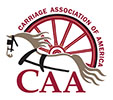F & R Shanks
London, England
Circa 1885
Type
The mail phaeton first appeared in England in the early years of the nineteenth century. The suspension was the same as that used on the English mail coach of 1805, i.e., with a combination of two side- and two cross springs, known as “telegraph” springs, at the front and, at the rear, a combination of three springs, i.e., two side elbow springs and one cross spring (a so-called “gallows” spring). The imitation cane-work on the seat panel has been done by the tube method, using paint mixed to a very thick consistency and applied by capillary feed from a metal tube. This panel is a very fine example of the high quality a skilled craftsman could achieve by this method on a surface with a double curvature. “Sham caning” by this method was often done in Britain by itinerant French craftsmen.
Mail phaeton with hood up
The mail phaeton was a gentleman’s carriage that might be used for pleasure driving or for travelling by “post,” that is, making a journey by stages, using hired post horses driven postilion by a postboy. It came to be seen as the ne plus ultra of gentleman’s driving carriages. The mail phaeton was designed for use with a pair of horses, and two grooms in livery would normally be carried on the rear seat.
Provenance:
This mail phaeton was purchased from Major E.N. Barran of Yorkshire, England, in 1968. Major Barran had bought it from a dealer in Harrogate in the 1930s and he believed it had formerly belonged to a member of the Curzon family who lived in Derbyshire. Major Barran was a regular soldier serving in a British cavalry regiment at that time, and he started driving with a pair of Hackney coach horses which he bought from H.J. Colebrook in 1937. In the spring of 1940, Major Barran was severely wounded and taken prisoner during the fighting in France. When he returned to England in 1945, he started a new career in business and moved to London. He then sold his horses, but not the carriages and harness, presumably with the intention of taking up driving again one day. Major Barran retired in 1966 and returned to live in Yorkshire, but two years later he realized that starting driving again would not be possible, and he reluctantly sold the phaeton to Mr. Seabrook.
Mail phaeton’s canework
The dash and splash guards of the phaeton were recovered with black harness leather by A. Galloway, a skilled hand-stitcher, before it was shipped to New Jersey. The painting was done more recently by Abner Lapp, but the original imitation canework remains.
Builder:
Robert Shanks started as a coachbuilder in Lincoln’s Inn Fields about 1840. Frederick Shanks, presumably Robert’s son, became a partner in 1860, and the new firm was then called F & R Shanks at 70/71 Great Queen Street, Lincoln’s Inn Fields. About 1895, the firm opened a new factory in Parker Street near Long Acre in London, and they started making bodies for automobiles there. The firm moved out of the Great Queen Street premises about 1905 and continued in business until about 1917, when they closed down. No records of the carriages they built are known to exist.

